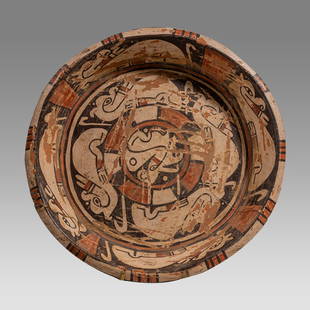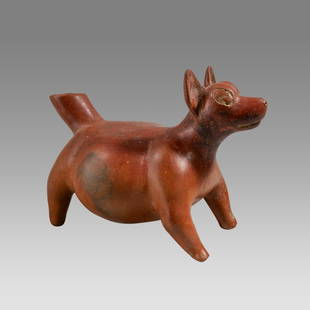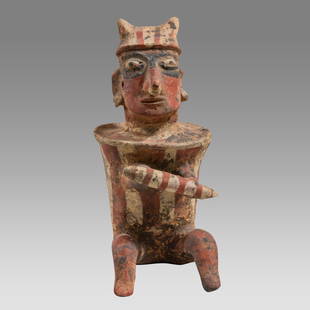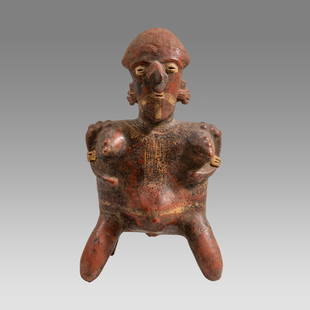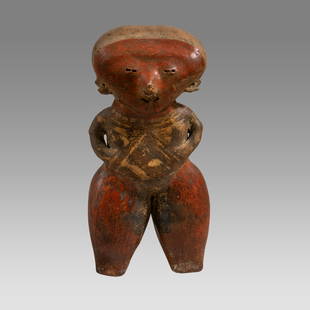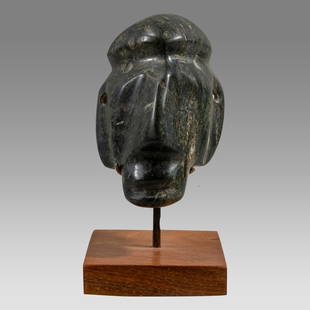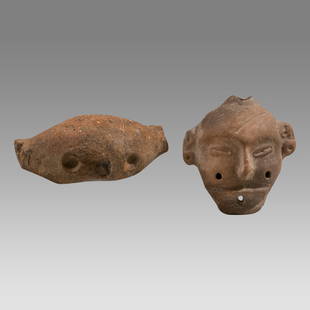
Magna Graecia red-figure crater, 4th century BC. Polychrome pottery. Provenance: Spanish private
Similar Sale History
Recommended Items







Item Details
Description
Magna Graecia red-figure crater, 4th century BC.
Polychrome pottery.
Provenance: Spanish private collection A.B.
Measurements: 31 x 32.5 cm.
Ceramic vessel with a circular base, a bell-shaped body with two handles, almost hidden under a pronounced rim at the top, which also opens outwards. The exterior of the piece is decorated on the obverse with the figures of Dionysus and a Menade, a figure from the Bacchic entourage, facing the front. The lady wears a chiton and holds a fiale in her right hand. The nude male figure, wearing only a toga covering his back, offers her a tray and holds a palm branch. The reverse shows two ephebos conversing.
The name of this type derives from its inverted bell shape, which opens from the base, a shape adapted to the function of this vessel. Craters such as this one were key utensils in the banqueting culture, as they were used to mix wine with water before drinking it, since the Greeks rarely drank pure wine. Once mixed with water, the wine was drunk directly from the krater using small vessels. The shape of the krater is therefore perfectly designed to facilitate the mixing of liquids and their subsequent extraction.
Red-figure pottery was one of the most important figurative styles of Greek pottery. It was developed in Athens around 530 BC, and was used until the 3rd century BC. It replaced the previous predominant style of black-figured pottery within a few decades. The technical basis was the same in both cases, but in the red figures the colouring is inverted, with the figures highlighted against a dark background, as if illuminated by a theatrical light, following a more natural scheme. Painters working with black figures were forced to keep the motifs well separated from each other and to limit the complexity of the illustration. The red-figure technique, on the other hand, allowed greater freedom. Each figure was silhouetted against a black background, allowing the painters to portray anatomical details with greater accuracy and variety. Over time these decorations became more complex, incorporating numerous details in both black and white, which enhanced the narrative and decorative sense of the depictions. The technique consisted of painting the motifs on the piece while it was still wet, using a transparent varnish which, when fired, acquired an intense black hue. The motifs were therefore invisible before firing, which meant that the painters had to work entirely from memory, without being able to see their previous work. Once the piece was fired, the unglazed areas remained with the reddish hue of the clay, while the glazed, "painted" areas took on a dense, glossy black colour.
Polychrome pottery.
Provenance: Spanish private collection A.B.
Measurements: 31 x 32.5 cm.
Ceramic vessel with a circular base, a bell-shaped body with two handles, almost hidden under a pronounced rim at the top, which also opens outwards. The exterior of the piece is decorated on the obverse with the figures of Dionysus and a Menade, a figure from the Bacchic entourage, facing the front. The lady wears a chiton and holds a fiale in her right hand. The nude male figure, wearing only a toga covering his back, offers her a tray and holds a palm branch. The reverse shows two ephebos conversing.
The name of this type derives from its inverted bell shape, which opens from the base, a shape adapted to the function of this vessel. Craters such as this one were key utensils in the banqueting culture, as they were used to mix wine with water before drinking it, since the Greeks rarely drank pure wine. Once mixed with water, the wine was drunk directly from the krater using small vessels. The shape of the krater is therefore perfectly designed to facilitate the mixing of liquids and their subsequent extraction.
Red-figure pottery was one of the most important figurative styles of Greek pottery. It was developed in Athens around 530 BC, and was used until the 3rd century BC. It replaced the previous predominant style of black-figured pottery within a few decades. The technical basis was the same in both cases, but in the red figures the colouring is inverted, with the figures highlighted against a dark background, as if illuminated by a theatrical light, following a more natural scheme. Painters working with black figures were forced to keep the motifs well separated from each other and to limit the complexity of the illustration. The red-figure technique, on the other hand, allowed greater freedom. Each figure was silhouetted against a black background, allowing the painters to portray anatomical details with greater accuracy and variety. Over time these decorations became more complex, incorporating numerous details in both black and white, which enhanced the narrative and decorative sense of the depictions. The technique consisted of painting the motifs on the piece while it was still wet, using a transparent varnish which, when fired, acquired an intense black hue. The motifs were therefore invisible before firing, which meant that the painters had to work entirely from memory, without being able to see their previous work. Once the piece was fired, the unglazed areas remained with the reddish hue of the clay, while the glazed, "painted" areas took on a dense, glossy black colour.
Buyer's Premium
- 23%
Magna Graecia red-figure crater, 4th century BC. Polychrome pottery. Provenance: Spanish private
Estimate €10,000 - €12,000
3 bidders are watching this item.
Shipping & Pickup Options
Item located in Barcelona, -, esOffers In-House Shipping
Payment

Related Searches
TOP








































